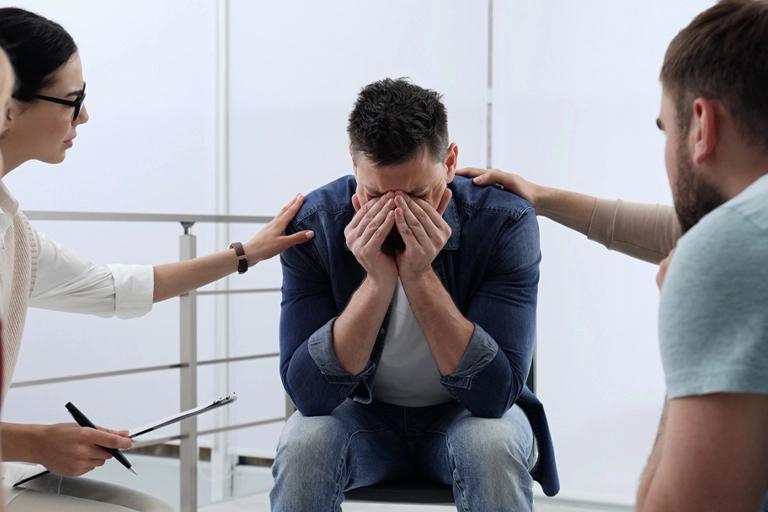For moderate to severe pain, doctors may prescribe opioids, but they have significant risks and side effects. Among the most prevalent opioids include oxycodone (OxyContin), hydrocodone (Vicodin), morphine, and methadone. Opioid painkiller Fentanyl is a synthetic opioid. It is approved for treating severe pain, often advanced cancer pain, and is many times more potent than other opioids. Illegal fentanyl manufacture and distribution have surged in several states. According to the CDC, illicit opioid heroin is responsible for approximately 40 deaths daily in the United States.
In other cases, opioids are combined with other medications, such as Tylenol (acetaminophen) and Advil (ibuprofen). Vicodin (hydrocodone and acetaminophen) and Percocet (oxycodone containing acetaminophen) are well-known brand names for this class of medicines.
What is Opioid Use Disorder?
Abusing or misusing medications or illegal drugs designed to alleviate pain or produce euphoria may lead to opioid use disorder (OUD).
Opioid addiction affects an estimated 2 million Americans. Over the last two decades, there has been a substantial increase in opioid-related fatalities; in 2020 alone, 68,000 people died from opioid overdose.
OUD is a complex condition that may be difficult to manage. It's a term used to describe the use of opioids in a way that causes clinically significant discomfort or impairment and the persistent desire to get and use opioids despite the terrible social, physical, and professional consequences. Long-term, compulsive opioid self-administration for non-medical reasons is the hallmark of opioid use disorder.
Common behaviors that may indicate OUD or opioid misuse include the following:
- Taking opioids in greater dosages or for a more extended period than prescribed
- Consistently want to minimize opioid consumption or make valiant but futile attempts to do so
- Acquiring, using, or recovering from opioids takes up time.
- Opioid cravings
- Inability to keep commitments at work, home, or school because of opioid use
- Using opioids, notwithstanding the recurrence of social or interpersonal problems that are caused by opioid use
- Refusing to participate in crucial social, occupational, or recreational activities because of opioids
- The use of opioids in potentially life-threatening conditions
- Even though one's health and well-being have been adversely affected by opioids, one continues to use them
- Having an opioid tolerance (does not apply when substance use is medically appropriate)
- Withdrawal or the need to use opioids as a result
Recovery Is An Acceptance That Your Life Is In Shambles And You Have To Change.

Symptoms of Opioid Use
There is a slew of indicators that somebody is abusing opioids. A person's friends and relatives may notice these things before they do:
- The inability to stop using the opioid or opioids altogether
- Attacks of hysteria
- An overabundance of desire
- Tiredness
- Money problems
- Alterations to one's sleep schedule
- Violation of the law, such as stealing
- Weight loss
- Being cut off from friends and relatives
- Flu-like symptoms, such as muscular aches
- A lack of personal hygiene
- Dramatic changes in mood
- Less desire for sex
- Sloppy use of words
- Inhaling too slowly or shallowly
- Intestinal issues
- A lack of coordination
- Intolerance for unpleasantness
- Excitation
Opioid overdose symptoms may be deadly. They include the following:
- A lack of sensitivity to stimuli
- Small pupils
- Irregular or absent breathing
- Vomiting
- A weak, erratic, or absent pulse
Do All People Who Take Opioids Develop Opioid Use Disorder?
Prescription opioids may cause physical dependence, leading to withdrawal symptoms when the medication is stopped. Opioid use disorder is not present, according to the DSM-5, when specific symptoms occur when using opioids under proper medical supervision.
The vast majority of addictions stem from a psychological cause. Substance abuse is not established by developing a natural biological response to continuous exposure to the substance.
Because of this, it is particularly true if the person does not suffer from drug cravings, difficulty obtaining adequate amounts, or other lifestyle problems due to drug use.
Opioid prescriptions after surgery or injury may result in decreased activity, but this is not the same as reduced activity due to seeking out or using opioid drugs. This is an important distinction.
Opioid use disorder isn't always linked to heroin or other illicit opioids. Since the 1970s, it has been recognized that some heroin users do not develop heroin use disorder.
Opioid users who develop an OUD differ from those who don't. For example, as soon as they begin to build a tolerance to the drug, they are seen to cut back or stop using it entirely. Also, they administer the substance more safely and significantly regulate their use. In addition, opioid users without an opioid addiction tend to socialize with people who do not use and do their best to detach drugs from their social life.
Compared to other drugs, opioids, and heroin cause more severe and long-lasting problems, although many opioid users claim their use is not detrimental. According to studies, persons with opioid use disorder already have serious mental health challenges. Those who do not develop this use disorder are often psychologically and socially healthier than those who do.
Contact Wish Recovery today if you’re ready to get started on the road to recovery.
Treatment and Recovery for OUD
Opioid substitution therapy with buprenorphine or methadone reduces mortality and morbidity. Naltrexone is another medication that helps prevent relapse and treats opioid overdoses. Non-pharmacologic behavioral therapy is helpful. Many people with OUD benefit from individual and group counseling, 12-step programs, and peer support.
Due to the significant incidence of opioid use disorder, physicians must continue to study opioids in detail to identify people at risk of addiction and assist them in discovering treatment centers and weaning off prescription opioids. OUD often has exacerbations and remissions, but relapse is always possible. Chronic relapsing illnesses share comparable symptoms and treatment adherence.
Opioid-dependent patients can abstain for lengthy periods and recover. Accidental overdose, suicide, and infectious diseases remain risks. Ending opioid use reduces risk.
Relapses are possible due to OUD's neurobiological nature. Opioid addiction untreated can have serious social, legal, economic, and health ramifications. OUD patients may face stigma. OUD is a treatable brain condition, not a personal failure or lack of resolve.
Behavioral therapy and counseling can help people develop appropriate opioid coping abilities and interactions. OUD therapy improves health and social functioning.
There are numerous dangers associated with taking opioids, even when taken as a prescription from a physician. One of the most common risks is the potential for addiction. If you or a loved one feels they are developing opioid use disorder, one of the best things you can do for yourself or that person is to seek help. Fortunately, top-rated treatment centers like Wish Recovery have various programs and resources dedicated to helping those struggling with addiction. Contact us today to learn more.



